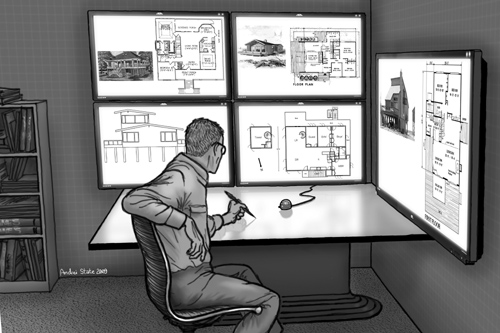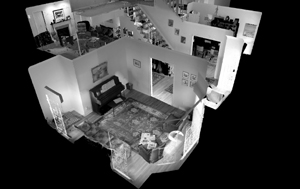18. A Computer Scientist’s Dream System for Designing Houses—Machine to Mind
Vision for a house design workstation
Drawing by Andrei State

When we mean to build,
We first survey the plot, then draw the model;
And when we see the figure of the house,
Then we must rate the cost of the erection;
Which if we find outweighs ability,
What do we then but draw anew the model
In fewer offices, or at least desist
To build at all?
WILLIAM SHAKESPEARE [1598],
HENRY IV, PART 2
Two-Way Channel
Mind-machine collaboration demands a two-way channel. The broadband path into the mind is via the eyes. It is not, however, the only path. The ears are especially good for situation awareness, monitoring alerts, sensing environment changes, and speech. The haptic (feeling) and the olfactory systems seem to access deeper levels of consciousness. Our language is rich in metaphors suggesting this depth. We have “feelings” about complex cognitive situations on which we need to “get a handle” because we “smell a rat.”
Visual Displays—Multiple Concurrent Windows
Computer-using designers have customarily worked with one active window. Yet computer scientists have long understood that designers need at least two, and that screen sizes have been far too small.1 What visual displays would one in fact want in a Dream System for Designing Houses?
The Drafting Table and Drawing View
Since I believe 2-D drawings will always be primary for actual design, the first display is an electronic drafting table.
• Angle. In standard manual drafting, a vertical display and tiltable work surface are perforce combined, but electronics liberates. Separating the two means the hand and arm no longer obscure the view. Studies show that users have no difficulty moving a mouse or pen on one surface correlated with a display on another.
• Work surface size. Drafting tables vary, but 30 × 48 inches is common. These dimensions are set by the arms’ reach.
• Display resolution. It should be that of the human eye, about one minute of arc—a 1,920-pixel computer screen at a distance twice its width. Such flat-screen displays now grace many offices.
• Display viewing distance. Projection on a screen 6 to 8 feet away relieves eyestrain for the individual designer.
The object on the table is almost always a 2-D drawing. The object on the screen may be the drawing, other renderings, and so on. Layering of the displayed drawings with controllable transparency, as is routinely done today, is an indispensable technique for focusing attention on some one aspect while maintaining conceptual context.
The 2-D Context View
In all our UNC systems where we’ve watched users doing real design work, whether architectural, molecular, or 2-D diagrams for publication, we see a universal sequence:
1. Study a big spatial chunk for context.
2. Zoom in.
3. Create or manipulate some local portion.
4. Zoom out.
5. Repeat.
Obviously, the historical limitation of one time-shared window enforced this unnatural and wasteful behavior. One wants a context view and a detailed view simultaneously, switching by movement of eyes rather than hand. We must provide that. Moreover, it won’t do to provide the context window as a thumbnail in some corner of the detailed view—one needs to see the details in it, too. With current prices, no serious design shop can have any excuse for being display-constrained. Have two big screens showing these two views all the time!
Usually, the context view will be spatial, normally the entire plan. But for operations such as object selection from a library, one view might well be the library (a hierarchical tree representation or the contents of a particular node), the other still the drawing where the object is to be placed.
The 3-D View
People live and move in 3-D houses, not 2-D abstractions. In the Dream System, the designer continually sees the 3-D house as currently specified—always in full detail.
Projection virtual-environment technology seems quite suited for this. One doesn’t want a completely immersive environment, such as a CAVE; a small vertical dome would be superb. Even a single standard 3-D view window would serve nicely. The designer is surely seated at the drafting surface, not walking about. He surely has a set of controls handy. This 3-D display is an auxiliary creation tool, whereas the CAVE was designed for viewing, not creation.
Several technical issues arise. First, one does not want to wear stereo glasses all the time while designing. The eyes work hard enough without that burden. So one wants a mode switch—perhaps a foot switch. Or, the 3-D display can be autostereoscopic.
Next, houses generally have flat walls, and so can projection screens. Of course, one wants the viewpointer, ideally an EyeBall, to control standard modes where yaw rotations spin the scene around the viewer and vice versa. But the Dream System also wants a snapping mode that aligns the view to a flat house surface.
Exterior Views
Especially useful viewings are the house from outside, with a wide field of view. As with interior views, one wants viewer controls of the hourly and seasonal positions of the sun.
Viewpoint control for exterior viewing is ideally different from that for interior viewing. One usually wants to specify x, y on the context display and to have view direction continually default toward the center of the house. Thus one easily walks around a house.
A dramatic exterior view is the house at night with the interior lights ablaze. The effect, if overly exploited by the painter Thomas Kinkade, is charming, attractive, homey.
I have found a third exterior view to be unexpectedly useful—the night view with the near wall dynamically eliminated. Circumnavigating a building in this mode gives a comprehensive grasp (Figure 18-1).
Figure 18-1 Cutaway view of an apartment

DeltaSphere, Inc.
The Workbook View
Yet another window concurrently displays the designer’s workbook. Designers come to design stations with
• In-progress designs
• Action plans
They take away
• Updated in-progress designs and future action plans
• Logs capturing all actions; these, or the version-control system, enable automatic backtracking
• Notes, ideally dictated so as to leave the hands free to design, as to what was tried, and why, what was rejected, and why, and what was kept, and why
The whys, which cannot be captured from the action log, are crucially important for any complex design. They wonderfully aid refreshment after interruption. They remind one of the branching thought trails skipped as one explored a particular design alternative. The whys are priceless for new team members and for a designer’s project heirs.
Ideally, the action plan and the resulting notes are interleaved in one document, distinguished by color or font.
In the Dream System, two page-corner inserts in the action log show the current value of the cost estimate and of some other budgeted commodity, such as square feet.
The Specification View
Construction requires not only drawings, but also prose specifications. Ideally, these grow to finality contemporaneously with the drawings, not afterward.
This is not nearly so hard as it first seems, given the progressive truthfulness mode of design. Specifications are highly stylized. If each of the starting models in the library has its specs, the designer can work by changing them as he goes. This task is made radically simpler by the vast collection long called Sweets File, now Sweets Network.2 Many million products are listed, pictured, described, and specified there. McGraw-Hill Construction maintains the file and its taxonomy; product vendors provide the contents; architects and contractors subscribe to the service. Everybody wins.
So the Dream System needs a fourth 2-D window, the continually refined prose specifications. Ideally, a change made in this display can be automatically reflected in the drawing display. Since many Sweets Network product descriptions already include CAD models in standardized form, this link is not conceptually difficult. Propagating changes from the drawing back to specification is much more difficult—a research problem.3
Audio Display
I was stunned, many years ago, to watch a videotape in which a group of Helsinki architects showed a computer graphics simulation of a proposed redevelopment project. The visuals were good but not exceptional. But the video included recorded playground sounds. Even though no people were visible, the offstage noises made the whole scene leap to life.
Delivering audio displays is easy; building the sound models to be displayed is challenging. One wants to plant, at locations both indoors and outdoors, sound sources: a TV, traffic, a washing machine, young children playing/squabbling. Then, as one walks through the virtual house, one wants to hear the result, to look for both pleasure and nuisance.
The necessary acoustic simulation technology is well in hand.4 What cannot currently be done in real time can be approximated and the display progressively refined. The march of processor speed will solve such difficulties.
The challenge is doors and windows. Which ones are open? How far? The combinations explode. Both designer specification and designer exploration seem easy in principle and tedious in practice. An obvious exploration aid would be a sound-intensity plot, as of ear height, gridded over the entire house drawing, and responding to interactive opening and closings of orifices. This visual display could suggest where to listen. The EyeBall is again a handy device for specifying the location and orientation in the model for the listening head.
Haptic Display
Haptic displays seem to get to our guts (and hearts) like no other modalities.5 Nevertheless, try as I might, I have not conceived of any plausible use of existing haptics technology in the Dream System.
Generalization
From the specifics of the Dream System for Designing Houses one can readily generalize to many other domains. A dream system for building software, for example, would not benefit from all the 3-D capabilities. But it should incorporate the rich starting library, the Design Display, the Context Display, the Workbook Display, and a Test Cases Display, all suitably cross-linked.
Feasibility
Can the Dream System now be built? Unquestionably, yes. All the technologies are well within reach. Can it now be an affordable tool even for relatively modest projects like the design of individual houses? I believe it can, at least in larger firms that can invest the capital and can time-share the system among multiple designers.
How would one build it? Incrementally! Any all-at-once project to build such a superficially pondered system would almost surely fail. But growing it, incrementally, with continual trials by real designers, would work. The hardest part would be assembling a good initial library of starting models.
One can imagine an academic research project that develops a framework, and the necessary standard input format and description format, and then solicits Open Source contribution of models. This is a place where the prestige incentive of the Open Source model could work well.6 I should think that architects might view having their house, room, or other project in the library as yielding not only prestige, but also advertising, like having it featured in a magazine. It would not be too hard to automatically winnow a massive central library based on usage. If it isn’t viewed, out it goes.
Notes and References
1. Brooks [1995], The Mythical Man-Month, 194.
2. http://products.construction.com/.
3. The heavy machinery in the system basement required to do two-way linking, even in the much simpler case of text editing, may be grasped from Ken Brooks’s Lilac system, described in “A two-view document editor with user-definable document structure” [1988] and “A two-view document editor” [1991]. The difficulty is that one view contains much more information than the other, so making modifications in the simpler view requires deducing and injecting information into the complex view.
4. Svensson and Kristiansen [2002], “Computational modelling and simulation of acoustic spaces.”
5. Meehan [2002], “Physiological measures of presence in stressful virtual environments.”
6. Raymond [2001], The Cathedral and the Bazaar, Chapter 4, “The magic cauldron.”
